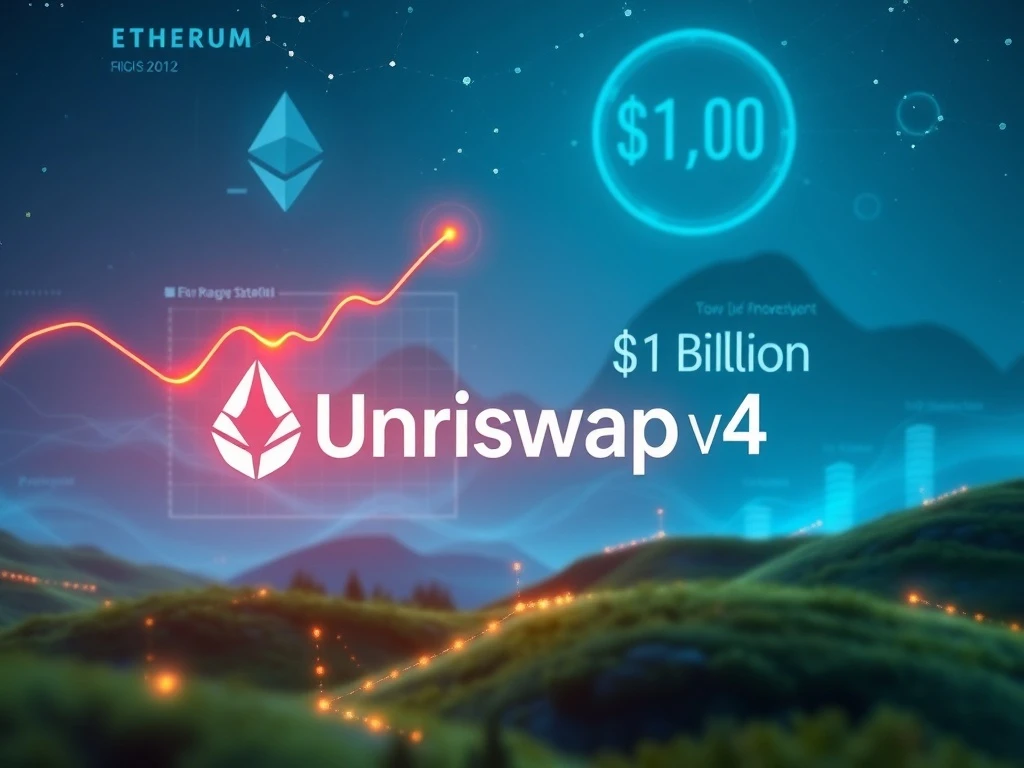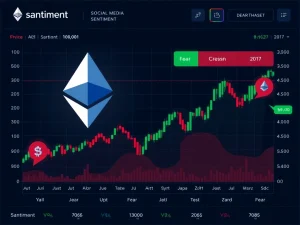Uniswap v4’s Astounding $1 Billion TVL Surge Propels Ethereum DeFi to New Heights

The decentralized finance (DeFi) landscape is buzzing with exciting news as Uniswap v4, the latest iteration of the pioneering decentralized exchange, has achieved a monumental milestone. Its Total Value Locked (TVL) has soared past an astounding $1.03 billion, with cumulative trading volume reaching an impressive $110 billion since its launch. This remarkable growth not only underscores renewed confidence from both institutional and retail participants but also solidifies Uniswap v4’s position as a foundational layer within the broader Ethereum DeFi ecosystem.
Uniswap v4: A New Era for Decentralized Finance
The latest iteration of the Uniswap protocol, Uniswap v4, marks a pivotal moment for decentralized finance. Surpassing $1.03 billion in Total Value Locked and accumulating over $110 billion in trading volume, these figures highlight the platform’s robust utility and growing adoption. Unlike its predecessors, Uniswap v4 introduces a revolutionary ‘Hooks’ architecture, which enables on-chain callbacks to execute custom logic at various points in a trade’s lifecycle. This innovation allows for:
- Customizable Liquidity Pools: Developers can implement unique fee structures, concentrated liquidity strategies, and even integrate external oracles.
- Dynamic Fees: Fees can adjust based on volatility or other market conditions, optimizing returns for liquidity providers.
- On-chain Limit Orders: Users can place sophisticated order types directly on the blockchain, enhancing trading flexibility.
These advanced features empower liquidity providers to optimize capital efficiency and offer traders a more flexible environment. The protocol’s design reflects a broader industry shift toward modular and interoperable DeFi solutions, positioning Uniswap v4 as a critical infrastructure layer for future decentralized applications.
The Astounding Rise of UNI Token and Market Dynamics
The success of Uniswap v4 is clearly reflected in the performance of its governance token, UNI token. In July alone, the UNI token surged by 60%, trading near $11.63. This price action aligns with a broader market optimism permeating the decentralized finance sector, signaling renewed investor interest and confidence in the long-term viability of DeFi protocols.
However, technical indicators suggest potential short-term consolidation for the UNI token. An overbought Relative Strength Index (RSI) of 71.30 indicates that the asset may be due for a pullback or period of sideways trading. While this signals potential near-term volatility, it’s a common occurrence after rapid price appreciation and does not necessarily diminish the underlying strength of the Uniswap ecosystem.
Further demonstrating the expanding utility of Ethereum-based liquidity solutions, protocols operating within the Uniswap v4 ecosystem, such as Bunni and EulerSwap, have each recorded over $1 billion in cumulative trading volume. This growth showcases the appeal of platforms that prioritize customization and offer developer-friendly tools, attracting both builders and users seeking advanced financial primitives.
Navigating the Competitive Landscape of Total Value Locked
While Uniswap v4’s achievements are significant, the decentralized finance landscape remains intensely competitive. The race for Total Value Locked (TVL) is a key indicator of a protocol’s health and user adoption. Currently, Ethereum-based decentralized exchanges (DEXs) face robust competition from alternative chains like Solana. For instance, Solana’s leading exchange, Raydium, boasts a TVL of $2.3 billion, which currently outpaces Uniswap v4.
Solana’s advantages, including its high transaction speeds and remarkably low transaction costs, appeal greatly to high-frequency traders and yield farmers. These characteristics present a formidable challenge to Ethereum’s long-standing dominance in institutional-grade liquidity. However, Ethereum’s established user base, larger trade sizes, and robust developer community provide a significant counterweight. Analysts acknowledge that Ethereum’s higher gas fees and slower transaction finality could pose long-term scalability hurdles, yet the protocol’s growing institutional adoption and its flexible, modular design offer a strong counterbalance to cross-chain competition.
Ethereum DeFi: Innovation Through Modular Design
The modularity of Uniswap v4, particularly through its ‘Hooks’ architecture, is a game-changer for Ethereum DeFi. With over 2,500 deployed Hooks, developers have unprecedented flexibility to create highly tailored liquidity strategies. This empowers liquidity providers to seek optimized returns by implementing custom logic directly into the AMM (Automated Market Maker) pools. Examples of what Hooks enable include:
- Custom Fee Tiers: Implementing variable fees based on specific asset pairs or market conditions.
- On-chain Oracles: Integrating price feeds directly into the pool for more dynamic operations.
- Automated Yield Strategies: Auto-compounding LP fees or redirecting them to external protocols.
- Risk Management Tools: Implementing circuit breakers or anti-sniper measures to protect liquidity.
This level of customization aligns perfectly with the industry trend toward interoperable DeFi protocols, where innovation is driven by the need to adapt and compete across different blockchain ecosystems. Protocols within the Uniswap v4 ecosystem, such as Bunni and EulerSwap, are already showcasing the platform’s potential to integrate advanced risk management tools with sophisticated AMM capabilities. This signals the next phase of DeFi’s development, where flexibility and programmability are paramount.
What’s Next for Uniswap v4 and the Decentralized Finance Ecosystem?
The coming months will serve as a crucial test for Uniswap v4 and its modular design. The ability to retain its competitive edge in a rapidly evolving market, particularly against high-performance chains like Solana, will be key. While Solana’s real-time execution environment continues to attract a segment of traders, Ethereum’s deep ecosystem resilience and Uniswap’s infrastructure-driven approach may yet redefine the trajectory of decentralized finance.
For now, the $1 billion Total Value Locked milestone reaffirms Uniswap’s indispensable role as a liquidity backbone for the entire decentralized finance landscape. As the industry’s competitive landscape intensifies, Uniswap v4’s innovative features and strong community support position it as a central player in shaping the future of digital finance.
Frequently Asked Questions (FAQs)
What is Uniswap v4?
Uniswap v4 is the latest iteration of the Uniswap decentralized exchange protocol, built on Ethereum. It introduces a new ‘Hooks’ architecture that allows developers to add custom logic and features to liquidity pools, enhancing flexibility, customization, and capital efficiency for both liquidity providers and traders.
What are ‘Hooks’ in Uniswap v4?
Hooks are smart contract plugins that can execute custom code at specific points during a trade’s lifecycle within a Uniswap v4 pool (e.g., before or after a swap, before or after adding/removing liquidity). They enable advanced features like dynamic fees, on-chain limit orders, custom oracle integrations, and sophisticated risk management tools.
Why is Uniswap v4’s TVL important?
Total Value Locked (TVL) represents the total amount of assets currently staked or locked within a DeFi protocol. A high TVL, like Uniswap v4’s $1.03 billion, indicates strong user trust, significant liquidity, and overall health and adoption of the platform, making it more attractive for large trades and institutional participation.
How does Uniswap v4 compare to Solana-based DEXs like Raydium?
Uniswap v4, built on Ethereum, benefits from Ethereum’s established user base and robust security. Solana-based DEXs like Raydium offer advantages in transaction speed and lower costs, attracting high-frequency traders. While Solana currently has higher TVL in some areas, Uniswap v4’s modular design and Ethereum’s institutional adoption offer distinct competitive strengths.
What is the significance of the UNI token’s recent surge?
The UNI token is Uniswap’s governance token, giving holders a say in the protocol’s future. Its recent 60% surge in July reflects strong market confidence in Uniswap v4’s innovations and the broader recovery and growth of the decentralized finance sector. It indicates increased investor interest and belief in the platform’s long-term value.










